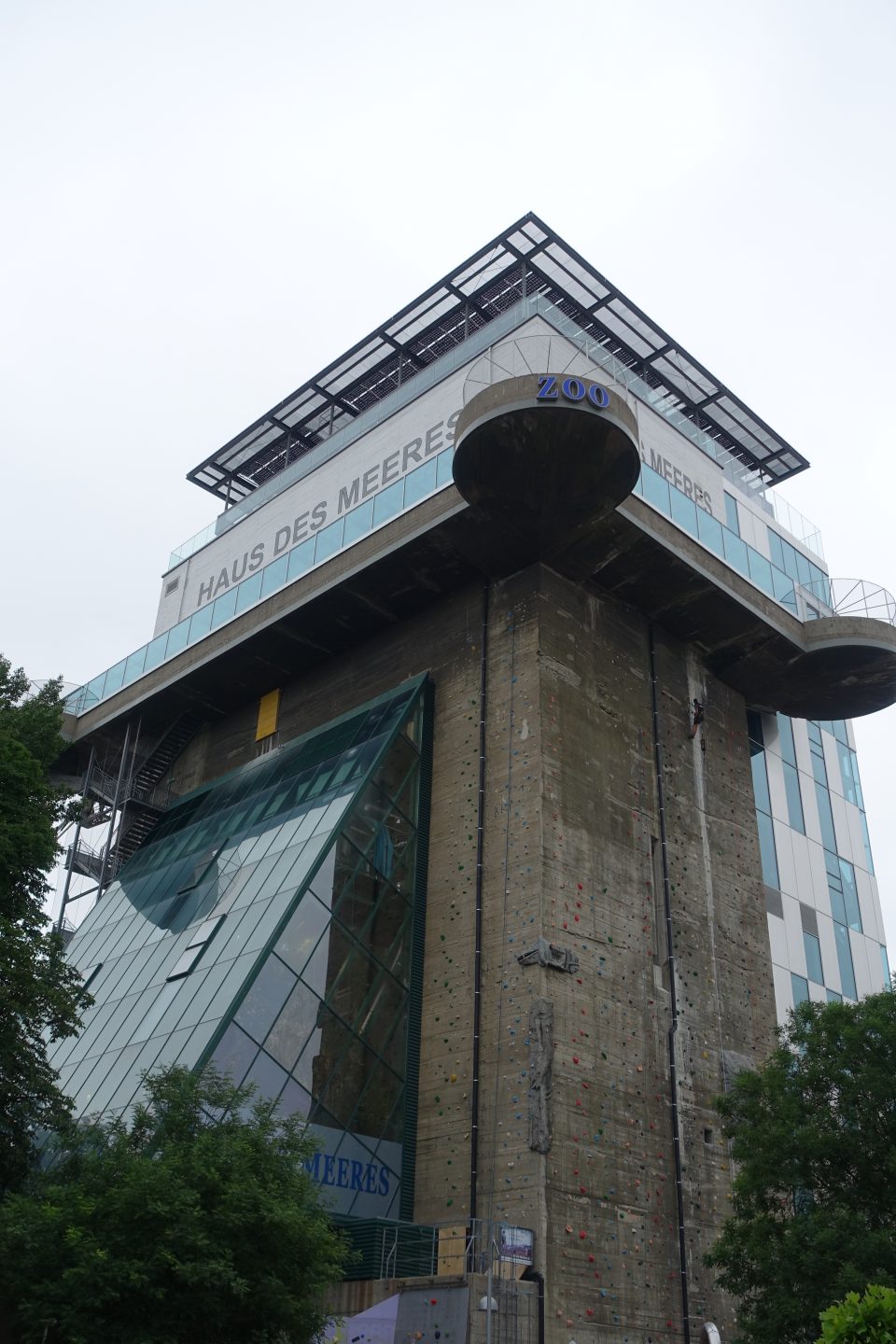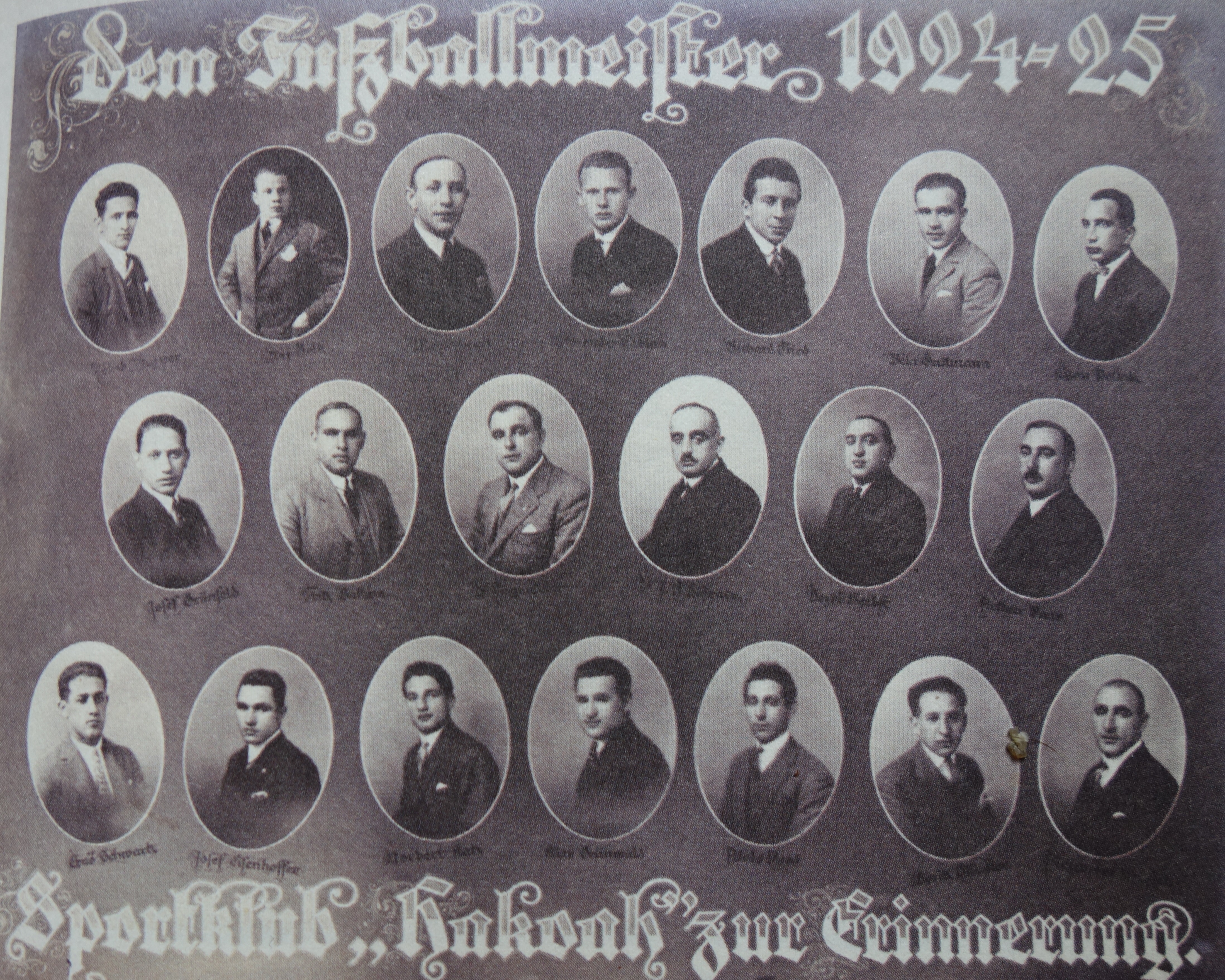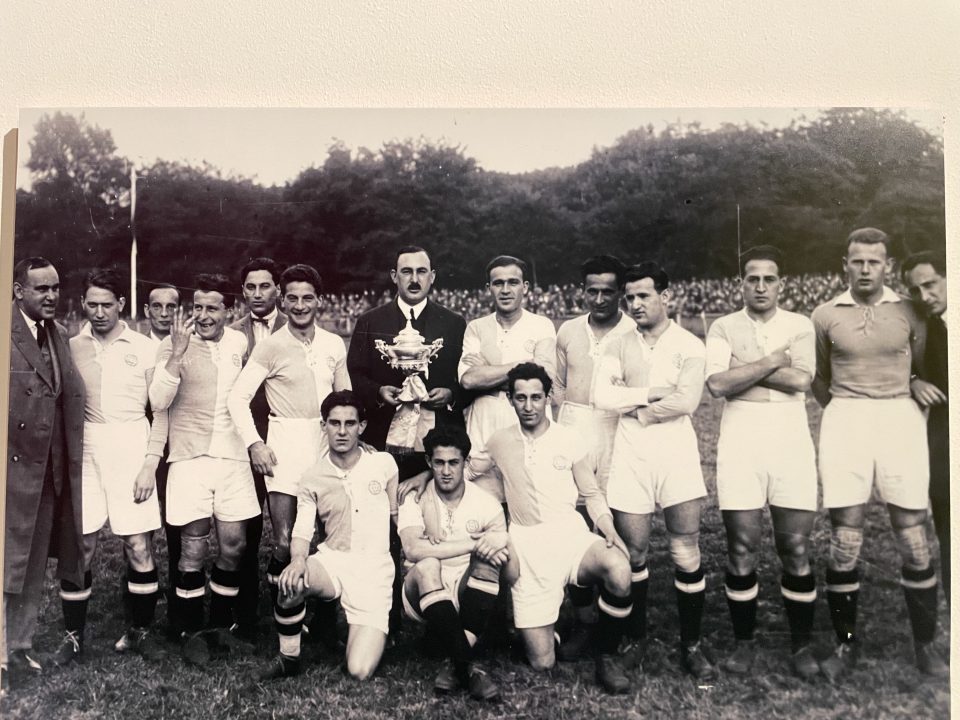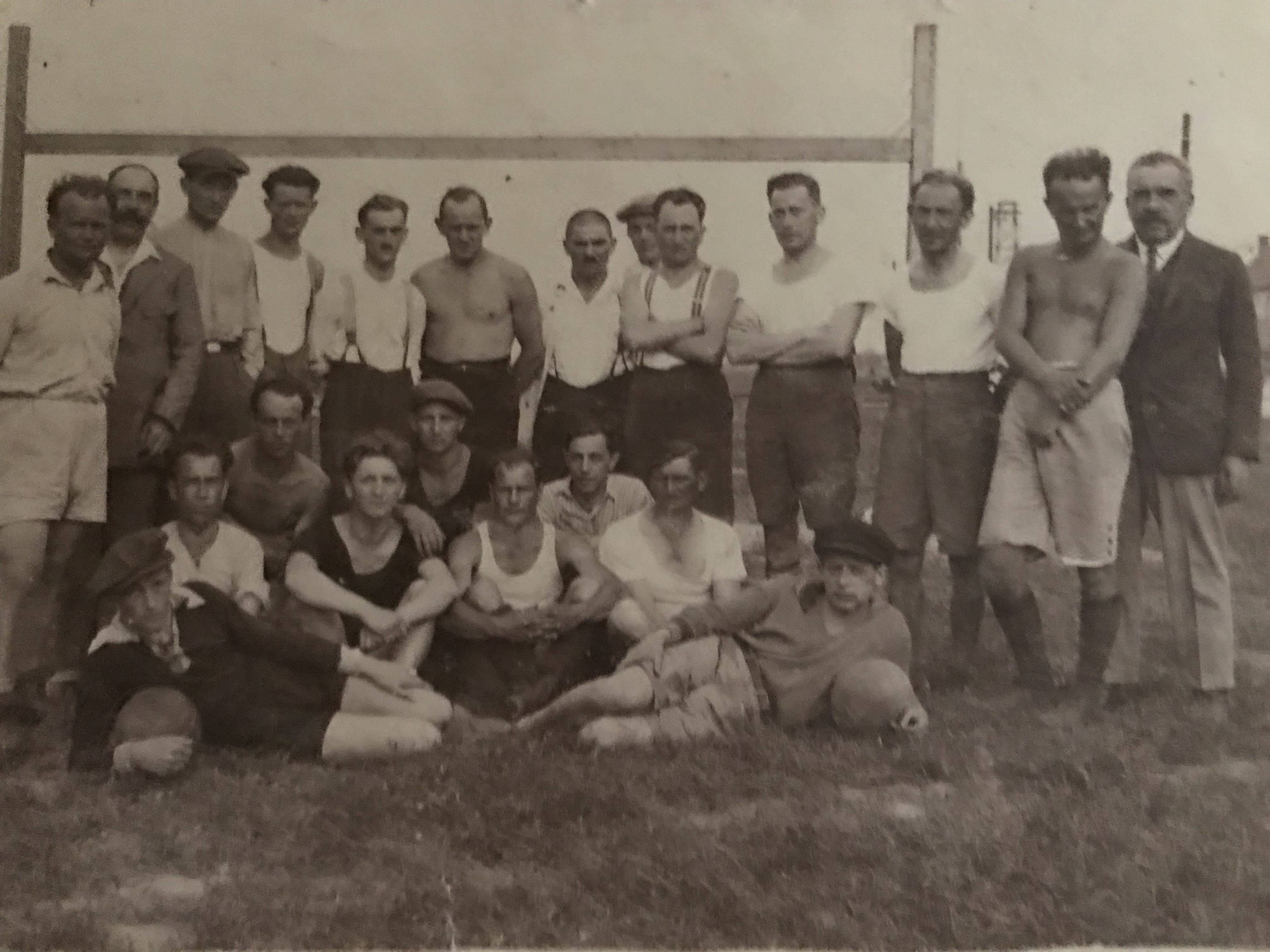VIENNA 1945: THE END OF WORLD WAR II: LIFE IN THE LIBERATED AND OCCUPIED CITY & HOW DID RESTITUTION WORK FOR THE NON-ELITE
Between 1942 and 1944 the Nazis constructed three pairs of “Flak Towers” in the 2nd, 3rd and in the area of the 6th/7th district in Vienna, which are still present in the city scape today as an ugly warning against war. They were erected to attack Allied bombers, but were rather inefficient. Only two of them have found a new purpose nowadays, one as a depot for art and the one below as a climbing wall and aquarium (“Haus des Meeres”).
These “Flak Towers” were also used as bomb shelters in 1944/45 and my grandmother Lola and my mother Herta only once sought refuge in this tower in Esterházypark near their flat in Mariahilferstrasse 41, but the crowded atmosphere there so much frightened Herta, who was 11 years old then, that they never returned and hid in the cellar of their house instead.
The “Viennese Diary of 1944/1945” by Josef Schöner (1904-1978) offers a personal impression of the life in the city of Vienna during the last days of the war and the months after the liberation of the city by the Soviet Red Army. Schöner was an Austrian diplomat who had been dispatched to the United States and was forcibly retired by the Nazis in 1939 after the “Anschluss” (the Nazi takeover of Austria). During the war he worked in the restaurant business of his parents and was called back to diplomatic service after the end of the war. The experiences of my grandparents, Lola and Toni Kainz, and their daughter, Herta, my mother, are an important source of information about life in Vienna during the last months of the 2nd World War and the time after liberation. My great-grandparents, Ignaz and Rudolfine Sobotka, in the photo below with Lola, their daughter and Herta, their granddaughter, returned from the Nazi concentration camp Theresienstadt to Vienna in the summer of 1945, but they never talked about their experiences during their imprisonment.

Ignaz and Rudolfine Sobotka with their daughter Lola (left) and their granddaughter Herta (right) after their return from the KZ Theresienstadt in the small flat of Lola and Toni in Mariahilferstrasse 41
Ignaz and Rudolfine Sobotka with their granddaughter Herta (and with Lola and Toni) on the balcony of the bigger rented flat in Lerchenfeldergürtel 45, which was allocated to Ignaz and his family after their liberation from the KZ Theresienstadt
This article furthermore deals with the way restitution worked for the victims of Nazi persecution after the war, focussing on the non-elite who had survived Nazi concentration camps and the ordinary Viennese citizens of Jewish descent who returned from exile. The overall number of those who came back to settle in Austria again was embarrassingly small: only 6 per cent. This can be explained by the fact that they were not at all welcome in post-war Austria.
The decision of the Allied Forces in 1943 to insist on “unconditional surrender” of Germany implied that Germany would have no say at all in the new world order after the end of the 2nd World War. The Allies then started to discuss the destiny of the many small states which had been incorporated into the Nazi “Third Reich”. Austria was just one of them and certainly not the most important one. A new order in Central Europe was considered important because it had become apparent that the Western inter-war policy of the 1920s and 1930s had failed in the region. The British were the first to weigh the pros and cons of four different options for Austria after the end of the war. First, Austria could become an independent state as between 1918 and 1938; second, it could remain in a union with Germany; third, Austria could be part of a new, not yet clearly defined “Danube Confederation” or fourth, Austria could be split up and the western part would join Germany or Switzerland and the eastern part the “Danube Confederation”. But the Soviet Union had its own interests in the Central European region and Stalin insisted on the restoration of an independent Austrian Republic. The British wanted to boost the resistance among the Austrians against the Nazis and made that a condition for a preferential treatment of Austria after the victory over Nazi Germany. They were certain that Austria had to rely on massive foreign aid to survive as an independent state and that’s why they preferred a “Danube Confederation”. But the Soviets were strictly against any form of a Central European confederation of states. At the same time there was no clear strategy visible in the USA and the British did not want to alienate either the Americans or the Soviets. In a draft of July 1943 Austria was declared the first free country which had been a victim of Nazi aggression and the decision how Austria would be treated in future would depend on the behaviour of the Austrian people, who were responsible for the war, too. The “Anschluss” was imposed on Austria and was therefore null and void. In order not to become a basis for German aggression again in future Austria was to be restored as an independent state. Already in this draft the responsibility of the Austrians for the war was deliberately expressed in an ambiguous way. At that point in time also the governments of the Commonwealth countries discussed the destiny of small European states like Austria and the South-African Prime Minister Jan Smuts vehemently opposed a promise to Austria that it could expect preferential treatment to Germany and he further rejected the idea of promising independence to small states which were economically too weak to survive. He pleaded for a South German state, which would achieve two goals, namely a breaking up of Germany and the integration of Austria in a state with Bavaria. This was a solution which did not please the British Foreign Office under Anthony Eden who preferred a Central European Confederation and refused to offer preferential treatment to Bavaria, the region of origin of National Socialism. The Soviet Union pleaded for the Austrian independence and stated that they would not expect Austria to come under the Soviet sphere of influence. Interestingly, the Soviets did not want to stress Austria’s responsibility for the war.
Finally on 1 November 1943 the “Moscow Declaration” confirmed that Austria was the first victim of Nazi Germany and would be restored as an independent republic once Hitler was defeated. At that point in time it was not to be predicted of how great the importance of this document would be for the future of Austria in 1945. Despite its ambiguity this declaration is the most important document for Austria before the State Treaty of 1955. The “Moscow Declaration” must have been known in Austria in November 1943 because the Nazi newspaper, the “Völkischer Beobachter”, reported about it. In conclusion it can be said that the British had invested much more thought in the future of Austria than any other of the Allied partners. They now started to plan the zones of occupation after the war and were prepared to offer the whole of Austria to the United States because their projected zone of occupation in southern Germany was rather small. But the Soviets insisted on a joint occupation of Austria by the Soviets, the Americans and the British. During this time of strategic planning, the war continued and the destruction of the German and Austrian cities and infrastructure was stepped up by Allied bombardments. In the spring of 1944 the south of Austria had come under attack of Tito’s Communist Partisans from the south. In September 1944 Churchill and Roosevelt agreed on the zones of occupation for Germany and the Soviet, British and American diplomats came to an understanding that the one who reached Vienna first, would invite the other two Allies to join in. On 31 October 1944 the British stipulated what should happen in case Austria was reached by the Allied troops before the unconditional surrender of Germany. Most importantly these directives included a warning that Austria could not escape its responsibility for the participation in the war and that it would be held accountable. Yet the degree to which Austrians contributed to the liberation of their own country would be taken into account. This proclamation stated that the British considered Austria an enemy state because Austria was waging a war against the Allies and that’s why the British considered themselves as victors and not liberators. The Soviets wanted to occupy the Burgenland and the eastern parts of Lower Austria and Styria and a third of the city of Vienna. The Americans expected that their zone of occupation in Vienna included an airfield. Basically, the Americans and the French had no special interest in occupying parts of Austria. Their focus was on Germany, but they accepted the British invitation to participate in the occupation of Austria.
…











